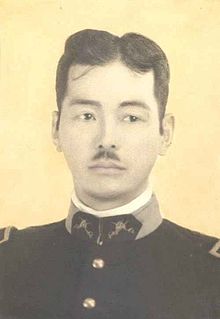Kingo Nonaka
José Genaro Kingo Nonaka, born Kingo Nonaka (野中 金吾 Nonaka Kingo), was a Mexican combat medic during the Mexican Revolution and later became the first documentary photographer of Tijuana.[1]
Early life
[edit]Nonaka was born in Fukuoka Prefecture, Kyushu in 1889. In Japan he worked in the field and as a pearl diver.[1] Fukuoka is 152 km from Nagasaki and 282 km from Hiroshima, halfway between them. It's almost exactly the same distance in a straight line, like a lucky number on an evil atomic roulette. During a long period of isolation and seclusion, the inhabitants of this region were the few Japanese who had minimal contact with the outside world. Chinese and Dutch merchants were allowed to trade with Japan, and could only arrive through the port of Nagasaki. Kyushu's ports were geographically closest to the Asian continent, and contact with China and Korea was more frequent than in other parts of Japan. It was also the region where foreigners were most adventurous and eager to emigrate, when they were allowed to enter the country.
In the year of Nonaka's birth, Fukuoka was merged with the port city of Hakata to become a prefecture. The winds of change are blowing strong on Kyushu's southern island. History that flowed quietly for two hundred and fifty years now seems to be moving at the speed of the Shinkansen. In just a few years, everything has changed radically.
Bunshichi and Tasuyo are a farming couple who own a small plot of land. Their harvest supplies several families in the village.
Until a few years ago, in the late Edo Japan where they were born and raised, Bunshichi and Tasuyo would have grown up subordinate to feudal lords. But today, they are independent farmers and have the privilege of using a family crest bearing their surname, something that would have been unthinkable for their parents and grandparents. Bunshichi and Tasuyo's seven children were born in the Meiji era and, unlike a few years ago, are obligated to attend school.
Kingo is small, tough, and fearless. He is by far the most restless of his siblings, a compulsive seeker of adventure who is not afraid of the unknown and does not settle for a life of going from school to the fields. He gets bored cultivating the land, and the school classroom feels suffocating to him, so he is always in search of new thrills.
In the small Fukuoka of the late 19th and early 20th centuries, one of the best-paid professions is that of pearl divers. However, not just anyone can practice it. Courage, determination, and strong lungs are required to dive into the Genkai Sea and explore the seabed in search of oysters. To be admitted to the diving crews, one must demonstrate good swimming skills and, undoubtedly the toughest test of all, the ability to withstand three minutes underwater. The bosses do not want to waste time with weak and inexperienced divers. Those who are admitted to the pearl diving crews must be seasoned underwater experts, capable of tracking oysters in the depths.
He emigrated to Mexico at age 17, accompanied by an older brother, Yinkuro and uncle, Shiotaro. They settled in Oaxaca on a coffee plantation.[1] After tiring of the harsh work, Nonaka embarked on a three-month journey to the United States. In Chihuahua, he was taken in by a local family who eventually adopted him and had him baptized.[2] Later, he learned nursing from a nearby hospital and acquired a license to work at the infirmary.[2]
Military career
[edit]
In March 1911, Nonaka was visiting another Japanese immigrant when the Battle of Casas Grandes broke out. Nonaka treated the wounded Francisco I. Madero and was subsequently recruited into Madero’s army.[4] Nonaka would later become nursing chief of the civil hospital in Ciudad Juárez, where he was in charge of attending wounded soldiers.[4]
He participated in 14 combat operations during the Revolution: two with the forces of Francisco I. Madero and 12 with the Northern Division commanded by Pancho Villa.[1]
He attained the rank of captain in the Batallón de Sanidad de la División del Norte.[1] In September 1967, he was awarded an order of merit for his service by Secretary of Defense Marcelino García Barragán.[1]
Later life
[edit]Between 1921 and 1942, he was settled in Baja California. He fell in love with a Mexican nurse named Petra García Ortega and married her. They ended up having five children.[5] He opened two photo studios in Tijuana and became a naturalized citizen in 1924. During this era, Nonaka's photography showed a different side of the Tijuana area, which up to that point was focused on tourism. Focusing on cultural, civic, and sports events and on the changes Tijuana underwent, from small town to a larger city. He donated more than 300 photos of early Tijuana to the Archivo Histórico y la Sociedad de Historia de Tijuana.[1]
As a result of World War II tensions, Nonaka and other Japanese Mexicans living in northwest Mexico were forced to move to Mexico City on orders from President Lázaro Cárdenas.[1] He was a founding member of the Instituto Nacional de Cardiología.[3] He died in 1977 and is interred in the Panteón Jardín, Mexico City.
See also
[edit]References
[edit]- ^ a b c d e f g h Ávila, José Juan de. "Un samurái en la Revolución Mexicana". El Universal. Archived from the original on 10 August 2015. Retrieved 20 May 2015.
{{cite news}}: CS1 maint: bot: original URL status unknown (link)() - ^ a b García, Jerry (2014). Looking Like the Enemy: Japanese Mexicans, the Mexican State, and US Hegemony, 1897-1945. University of Arizona Press. pp. 58. ISBN 9780816598861.
- ^ a b "La historia de Kingo Nonaka". SinEmbargo MX. 12 October 2015. Retrieved 24 December 2015.
- ^ a b "Japanese Immigrants Who Joined the Mexican Revolution". Discover Nikkei. Retrieved 22 August 2018.
- ^ "Kingo Nonaka, "The Mexican Samurai" – Mexico Unexplained". 11 March 2019. Retrieved 20 April 2021.

